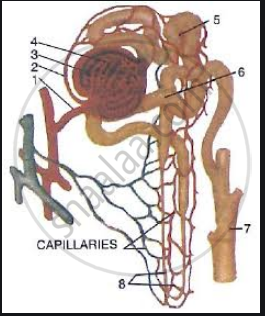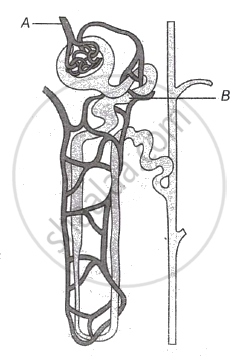Advertisements
Advertisements
प्रश्न
Answer the following question:
Explain the human excretory system with the help of a suitable diagram.
उत्तर
Describe the excretory system in human beings.
- Human excretory system

- The excretory system in human beings includes a pair of kidneys, a pair of ureters, urinary bladder and urethra. Kidneys remove the waste products from the blood and form urine.
- Kidneys are two bean-shaped structures located at the back of the abdomen, one on either side of the vertebral column. The right kidney is placed slightly lower than the left kidney.
- Though the kidneys are the major excretory organs in a human being, the skin and the lungs also help in the process of excretion.
- An average person has around 5 litres of blood which the kidneys filter about 400 times a day. Kidneys filter out about 190 litres of filtrate daily to produce 1-1.9 litres of urine, rest is reabsorbed.
APPEARS IN
संबंधित प्रश्न
The diagram given below shows a section of human kidney. Study the diagram carefully and answer the questions that follow :

(i) Label the parts numbered 1 to 4.
(ii) Why does part ‘2’ have a striped appearance?
(iii) What is the fluid that passes down part ‘4’? Name the main nitrogenous waste present in it.
(iv) Mention the structural and functional units of kidneys.
(v) Name the two major steps in the formation of the fluid mentioned in Q.5 (a) (iii).
Write the functions of Ureter
Define excretion
Name the procedure used in the working of artificial kidney.
Name the two waste products of the human body which are produced in the body cells.
What do kidneys excrete?
Draw a neat labelled diagram of the human excretory system.
The excretory organs in an earthworm are:
(a) nephridia
(b) nephrons
(c) raphides
(d) ureters
Fill in the blank.
.................. produces bile pigments from the heamoglobin of broken RBCs.
Name the following:
The part of kidney tubules where the term urine is first used for the fluid in it.
Name the following:
The vein in which urea concentration is maximum
The following diagram represents a mammalian kidney tubule (nephron) and its blood supply.

Parts indicated by the guidelines 1to 8 are as follows:
1. Afferent arteriole from renal artery
2. Efferent arteriole
3. Bowman's capsule
4. Glomerulus
5. Proximal convoluted tubule with blood capillaries
6. Distal convoluted tubule with blood capillaries
7. Collecting tubule
8. U-shaped loop of Henle
Study the diagram and answer the question that follow:
Which structure (normally) contains the lowest concentration of glucose?
Describe in brief how urine is produced in the human body.
Draw a labeled diagram of the human kidney as seen in a longitudinal section.
Complete the following sentence with appropriate words:
The outer surface of the kidney is ______ while the inner surface is ______.
Write the functional activity of the following structure:
Glomerulus
Hypotonic filtrate is formed in _______.
Identify the correct labels for A and B in the following diagram

The statement given below is false. Rewrite the correct form of the statement by changing the underlined word.
The pigment urochrome is the breakdown product of the haemoglobin of dead RBCs.
Choose the odd one out in the following set and write the category for the remaining terms:
